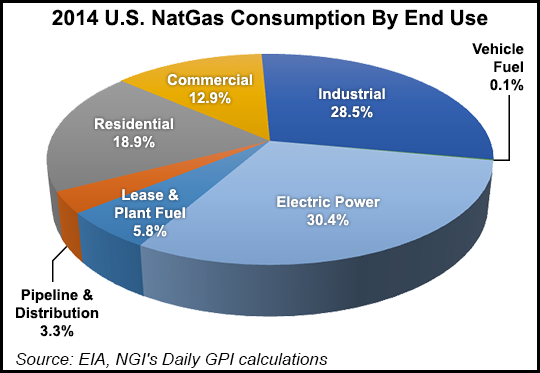Infrastructure | NGI All News Access | NGI The Weekly Gas Market Report
NGV Market Penetration Still Small Despite Bullish Advocates
While national and global market penetration is still modest, advocates for natural gas vehicles (NGV) could be heard at recent energy conferences in Chicago and Denver adding more fuel to the fire of enthusiasm among major fleet operators for natural gas as a transportation alternative.

At the LDC Mid-Continent Gas Forum in Chicago (Sept. 14-16), Chris Shorts, the gas supply/customer support director for Spectra Energy Corp.’s Union Gas Ltd., said NGVs in the long-haul trucking sector are part of Union’s demand growth strategies. It’s an extension of the Ontario-based utility’s industrial growth initiatives, he said.
“We have a whole group that is working on the transportation sector, focused on long-haul trucking,” Shorts said. “There are lots of roads in Ontario and we have to transport stuff long distances, so we’re looking at using compressed natural gas [CNG] or liquefied natural gas [LNG] in that sector.”
Shorts said Union is also looking to market CNG and LNG in remote locations beyond the reach of their pipelines. “In some of the remote mining communities in northern Ontario, we’re looking at end-use ways to use CNG or LNG to be connected to the energy world that way,” he said. “It is definitely a new sector for us, but we were into NGVs about 20 years ago.”
Overall, Union sees challenges, but “even more opportunities” in the industrial sector for load growth, Shorts said.
At the Natural Gas Vehicles of America (NGVAmerica) conference in Denver, United Parcel Service (UPS) said it hopes to have 4,400 NGVs and a total of 7,800 alternative fuel vehicles in its fleet by the end of next year.
“With our NGVs alone, we estimate we have displaced 50 million gallons of diesel and gasoline annually,” said Mike Whitlatch, UPS vice president for global energy and procurement.
NGVAmerica emphasized, however, that natural gas for transportation is still at a relatively low level nationally and globally, with 152,000 NGVs in the U.S. and 15 million worldwide. The conference emphasized that growth in U.S. heavy duty and medium-duty fleet markets in 2014 hit 30% and 24%, respectively.
Whitlatch said UPS has added use of renewable natural gas (RNG) as a cleaner alternative in the longer term. “The switch to NGVs allows us to seamlessly switch to RNG in the future,” he said.
At the LDC Gas Forum, Donald Barnes, energy manager for the State of Illinois, said the changing global LNG market — with China cutting back its growth and global oversupply becoming an issue — could create opportunities for the state’s efforts in using alternative fuel vehicles, including NGVs.
“It is clear that LNG may be part of the longer term equation, but it is uncertain when it will catch on, or how quickly that will happen,” Barnes said.
Ryder System Inc. announced earlier in the month that it is offering new 160- and 180-diesel gallon equivalent (DGE) CNG fuel cylinder assemblies as part of a Quantum back-of-the-cab system on long-haul trucks that Ryder leases and rents. Quantum CEO Brian Olson said Ryder’s move is “opening a new frontier for CNG in long-haul trucking.” The advanced fueling systems offer a “new value proposition” for users, said Ryder’s Scott Petty, vice president for supply management and global fuel products.
Meanwhile, the California Air Resources Board (CARB) certified on Sept. 10 as “near zero emission” the 8.9-liter ISL G natural gas engine by Cummins Westport, determining that it emits just 0.02 grams/brake horsepower, which equates to 90% cleaner than existing nitrogen oxide standards of 0.2 grams, effective since 2010. Industry officials expect the federal Environmental Protection Agency to follow suit with its own certification. Cummins Westport is working on similar reductions for its 11.9-liter ISX12 G and 6.7-liter ISB6.7 G natural gas engines, according to the newsletter Fleets and Fuels.
The new engines, when combined with the increased use of RNG — biomethane — make feasible California’s very aggressive plans for emissions and greenhouse gas controls.
CARB recently released a report on the state’s latest round of Proposition 1B funding for clean trucking and shipping under a Goods Movement Emissions Reduction Program that is slated to be the subject of a board meeting at CARB Thursday and Friday (Sept. 24-25).
CARB’s staff is recommending spending another $267 million to lower emissions, divided among truck projects ($166.1 million), locomotives ($69.6. million), ships ($20.2 million), transportation refrigeration ($10.4 million), and harbor craft ($600,000).
Regarding NGV equipment advances, the Luxfer G-Stor CNG composite fuel systems have been selected by McNeilus Truck & Manufacturing for its refuse trucks. McNeilus officials said the lightweight design of the Luxfer Type II and Type IV CNG tanks offers an option for refuse vehicles wanting to use natural gas as a fuel. The Luxfer NGen Tailgate system is available in 60, 75, 90 and 105 DGE capacities.
At the NGVAmerica conference, a pistol grip nozzle for CNG was introduced by OPW, a Dover company. The nozzles are available for 3,600 psi and 3,000 psi fueling and in 12 configurations, depending on customer needs. They have various features, including high-flow/gas-fit capability.
© 2024 Natural Gas Intelligence. All rights reserved.
ISSN © 1532-1231 | ISSN © 2577-9877 | ISSN © 1532-1266 |
